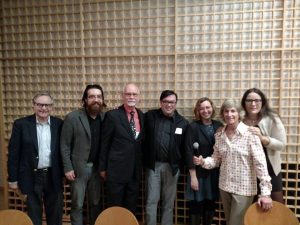Arts Journalists Offer Tips, Insight on Trends
About 100 people got up extra early for the media arts panel hosted by the San Diego Regional Arts & Culture Coalition last week at the Mingei International Museum.
They wanted to get valuable advice from respected panelists: Ken Herman, SanDiegoStory.com; Michael Rocha, UT; Kinsee Morlan, VOSD; Nina Garin, KPBS; Chris Jennewein, Times of San Diego; and Seth Combs, CityBeat. Toni Robin of TRPR moderated with style.

Panelists included from Left: Chris Jennewein, Seth Combs, Ken Herman, Michael Rocha, Nina Garin, and Kinsee Morlan. Toni Robin, seen with microphone, moderated.
The panel and participants were candid when sharing ideas on trends and tips for organizations and public relations. Here’s what we learned:
More and more organizations are taking their programming to the audience.
Barrio Logan may be the next arts mecca. Bread and Salt is on the hot list.
Interest in arts criticism is returning because it creates greater dialogue.
Arts organizations are encouraged to advocate for themselves and collaborate with other groups to draw more attention. (Dance troupes have done this forever).
Arts support is a two-way relationship. If you like what arts reporters publish, support them by sharing their stories, buying an ad, and pledging money every month or year.
PR and arts organization professionals can make the journalist’s job easier:
Keep sending emails. They get more than 100 emails a day and might miss yours the first time.
Facebook invites are not enough. Send concise email invitations and explain what they might see. (You laugh, but some invites don’t have a date, said one panelist).
Give early notice of an event. Many journalists need at least three weeks in advance. Magazines require several months.
Send high resolution images to print hybrids and online publications. Images can be sized down but cannot be increased. Standard is 300 dpi.
Provide complete captions with names.
Provide horizontal headshots.
Don’t be afraid to suggest a revision. If there’s a new image, new information, or a correction, it’s okay to help the journalist revise and improve the article that will live online forever.
For more information, visit www.sdracc.org
San Diego CityBeat Voice of San Diego Times of San Diego SanDiegoStory KPBS U-T Entertainment
TR/PR Public Relations & Marketing

Kris Eitland covers dance and theater for Sandiegostory.com and freelances for other publications, including the Union Tribune and Dance Teacher Magazine. She grew up performing many dance styles and continued intensive modern dance and choreography at the Univ. of Minnesota, Duluth, and San Diego State Univ. She also holds a journalism degree from SDSU. Her career includes stints in commercial and public radio news production.
Eitland has won numerous Excellence in Journalism awards for criticism and reporting from the San Diego Press Club. She has served on the Press Club board since 2011 and is a past president. She is a co-founder of Sandiegostory.com. She has a passion for the arts, throwing parties with dancing and singing, and cruising the Pacific in her family’s vintage trawler. She trains dogs, skis, and loves seasonal trips to her home state of Minnesota.
